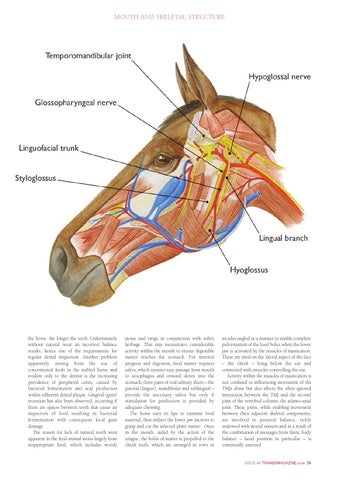MOUTH EURO ISSUE 44_Jerkins feature.qxd 16/12/2013 11:29 Page 2
MOUTH AND SKELETAL STRUCTURE
the horse, the longer the teeth. Unfortunately without natural wear an incorrect balance results, hence one of the requirements for regular dental inspection. Another problem apparently arising from the use of concentrated feeds in the stabled horse and evident only to the dentist is the increasing prevalence of peripheral caries, caused by bacterial fermentation and acid production within adherent dental plaque. Gingival (gum) recession has also been observed, occurring if there are spaces between teeth that cause an impaction of food resulting in bacterial fermentation with consequent local gum damage. The reason for lack of natural tooth wear apparent in the feral animal stems largely from inappropriate food, which includes woody
stems and twigs in conjunction with softer herbage. This mix necessitates considerable activity within the mouth to ensure digestible matter reaches the stomach. For internal progress and digestion, food matter requires saliva, which ensures easy passage from mouth to oesophagus and onward down into the stomach; three pairs of oral salivary ducts – the parotid (largest), mandibular and sublingual – provide the necessary saliva but only if stimulation for production is provided by adequate chewing. The horse uses its lips to examine food material, then utilises the lower jaw incisors to grasp and cut the selected plant matter. Once in the mouth, aided by the action of the tongue, the bolus of matter is propelled to the cheek teeth, which are arranged in rows or
arcades angled in a manner to enable complete pulverisation of the food bolus when the lower jaw is activated by the muscles of mastication. These are sited on the lateral aspect of the face – the cheek – lying below the ear and connected with muscles controlling the ear. Activity within the muscles of mastication is not confined to influencing movement of the TMJs alone but also affects the often ignored interaction between the TMJ and the second joint of the vertebral column, the atlanto-axial joint. These joints, while enabling movement between their adjacent skeletal components, are involved in postural balance, richly endowed with neural sensors and as a result of the combination of messages from them, body balance – head position in particular – is continually assessed.
ISSUE 44 TRAINERMAGAZINE.com 39
